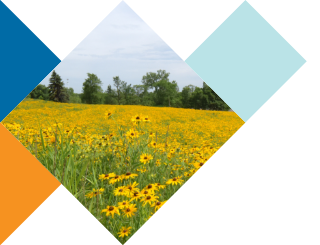
Pollinator habitat
For more than a decade, Great River Energy has worked to re-establish 300 acres of native habitat at our facilities and along transmission lines. This is just one example of Great River Energy’s commitment to environmental sustainability.
Importance of honey bees, butterflies and other pollinators
Pollinators, including bees, butterflies, moths, hummingbirds and bats, assist plants in reproduction by transferring pollen, allowing those plants to produce berries, nuts and other foods important to the survival of many species of wildlife and the human food supply. The ecological service pollinators provide is necessary for the reproduction of over 85 percent of the world’s flower plants, including more than two-thirds of the world’s crop species.
Importance of native pollinator habitat
Native habitat refers to the plants, grasses and trees which originated in an area before they were replaced with roadways, manicured lawns, crops and non-native gardens, or degraded for other reasons. “Pollinator-friendly habitat” more specifically refers to those plants and flowers that pollinators need to eat, live and do their work. Recently there have been many reports of a steady decline in the population of pollinators, due in large part to the loss of the habitat they need to survive.
Our commitment to pollinator habitat
Great River Energy is actively making contributions to the nationwide effort to restore the native habitat that is vital to restoring healthy populations of pollinators such as birds, bees and butterflies. We are partnering with
our members’ local schools to teach students about the importance of pollinator habitat.
We have been re-establishing native habitat where we can for years, and we continue to partner with experts and seek opportunities for new projects. These projects support our commitment to investing in Minnesota communities and finding innovative solutions to manage costs. We have restored approximately 300 acres to native habitat.
Some of our projects include:
- Nine acres of native pollinator habitat on our Elk River campus.
- Partnership with Laurentian Environmental Learning Center
- Great River Energy partnered with the Laurentian ELC to plant pollinator-friendly habitat along their solar array and in their interpretive center in fall 2016.
- Elko New Market Transmission Line Project
- Great River Energy partnered with Three Rivers Park District to restore pollinator-friendly habitat along a transmission right of way in 2016
- Partnership with Wolf Ridge Environmental Learning Center
- Great River Energy partnered with Wolf Ridge to plant pollinator-friendly habitat along their solar array and in their interpretive center in fall 2015.
- Elk River Terraces
- In 2014, Great River Energy partnered with Prairie Restorations to restore pollinator-friendly habitat.
- City of Ramsey (Alpine Park) on Great River Energy transmission line right of way
- In 2013, Great River Energy worked with the City of Ramsey to plant pollinator-friendly habitat along the right of way in Alpine Park.
- Great River Energy’s headquarters building in Maple Grove, Minn.
- In 2008, Great River Energy incorporated pollinator-friendly habitat into its design and construction of its Maple Grove headquarters building.
- Peaking plants
- In 2005, Great River Energy worked with Prairie Restorations to seed 80 acres near Lakefield Junction Peaking Station and 70 acres near Pleasant Valley Peaking Station.
- Restoring prairie near our New Prague office
- In 2004, Great River Energy partnered with Prairie Restorations to restore 2.5 acres into native habitat.
Talk to the experts
If you want to make a contribution to restoring native habitat for wildlife and pollinators, or want to simply to reap the practical benefits of landscaping with prairie or pollinator habitat rather than traditional trees, grass or shrubs, there are many resources and experts available to help you.